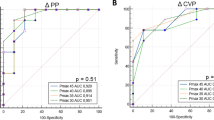Abstract
Restoration and maintenance of adequate circulating blood volume is an essential goal in the proper management of the critically ill patient. Hypovolemia ending up in irreversible circulatory shock as well as hypervolemia with its consecutive risk of hydrostatic pulmonary edema and cardiac volume overload have to be carefully avoided.
Access this chapter
Tax calculation will be finalised at checkout
Purchases are for personal use only
Preview
Unable to display preview. Download preview PDF.
Similar content being viewed by others
References
Abel FL, Waldhausen, JA, Daly WJ, Pearce WL (1967) Pulmonary bloodvolume in hemorrhagic shock in the dog and the primate. Am J Physiol 213: 1072–1078
Batson GA, Chandrasekhar KP, Payas Y, Rickards DF (1972) Measurement of pulmonary wedge pressure by flow directed Swan-Ganz catheter. Cardiovasc Res 6: 748–752
Buchbinder N, Ganz W (1976) Hemodynamic monitoring invasive techniques. Anesthesiology 45: 146–155
Chaudry IH, Baue AE (1982) Overview of hemorrhagic shock. In: Cowley RA, Trump BF (eds) Pathophysiology of shock, anoxia and ischemia. Williams & Wilkins, Baltimore, 203– 219
Chien S (1971) Hemodynamics in hemorrhage: influences of sympathetic nerves and pentobarbital anesthesia. Proc Soc Exp Biol Med 136: 271–275
De Laurentis DA, Hayes M, Matsumoto T, Wolferth CC (1972) Does central venous pressure accurately reflect hemodynamic and fluid volume patterns in the critical surgical patient? Am J Surg 126: 415–418
Erhardt W, Zänker K, Tölle W, Wriedt-Lübbe I, Probst J (1977) Experimentelle Untersuchungen zur Pathogenese der akuten pulmonalen Insuffizienz. Res Exp Med 171: 163–172
Fitzpatrick DF, Hampson LG, Burgess JH (1972) Bedside determination of left atrial pressure. Can Med Assoc J 106: 1293–1298
Frostell C, Blomqvist H, Hedenstierna G, Pieper R, Halbig I (1986) Effects of prolonged surgical trauma on the extravascular lung water and central blood volume in the dog. Acta Anaesthesiol Scand 30: 309–313
Frostell C, Blomquist H, Wickerts C-J (1987) Effects of PEEP on extravascular lung water and central blood volume in the dog. Acta Anaesthesiol Scand 31: 711–716
Gauer OH, Henry JP, Sieker HO (1956) Changes in central venous pressure after moderate hemorrhage and transfusion in man. Circ Res 4: 79–84
Gersmeyer EF, Yasargil EC (1978) Schock und hypotone Kreislaufstörungen. Pathophysiologic -Diagnostik-Therapie. Thieme. Stuttgart: 25– 30
Hedenstierna G, Strandberg A, Brismar B, Lundquist H, Svensson L, Tokics L (1985) Functional residual capacity, thoracoabdominal dimensions, and central blood volume during general anesthesia with muscle paralysis and mechanical ventilation. Anesthesiology 62: 247–254
Humphrey CB, Oury JH, Virgilio RW, Gibbons JA, Folkerth TL, Shapiro AR, Fosburg RG (1976) An analysis of direct and indirect measurements of left atrial filling pressure. J Thorac Cardiovasc Surg 71: 643–647
Jacobson ED (1968) A physiologic approach to shock. New Engl J Med 278: 834–839
Lappas D, Lell WA, Gabel JC, Civetta JM, Lowenstein E (1973) Indirect measurement of left-atrial pressure in surgical patients. Pulmonary-capillary wedge and pulmonary artery diastolic pressures compared with left-atrial pressure. Anesthesiology 38: 394–397
Leevy CM, Stein SW, Cherrick GR, Davidson CS (1959) Indocyanine green clearance. A test of liver excretory function. Clin Res 7: 290–296
Marshall RJ, Wang Y, Shephard JT (1960) Components of the “central” blood volume in the dog. Circ Res 8: 93–100
Necek S (1983) Zur Relevanz der Ermittlung intraalveolärer Flüssigkeit mittels Messung des extravaskularen Lungenwassers (EVLW). H Unfallheilk 156: 504–508
Pfeiffer H-G, Heinkelmann W, Petrowicz O, Blümel G (1977) Kinetics of hematoma and diagnosis of hypovolemia by double isotope determination of total blood volume. Europ Surg Res 9 [Suppl 1]: 19
Pfeiffer U, Birk M, Aschenbrenner G, Blümel G (1982) The system for quantification of thermaldye extravascular lung water. In: Parakash O (ed) Computers in critical care and pulmonary medicine, vol 2. Plenum, London, pp 123–125
Shoemaker WC (1987) Relation of oxygen transport patterns to the pathophysiology and therapy of shock states. Intensive Care Med 13: 230– 234
Tooker J, Huseby J, Butler J (1978) The effect of Swan-Ganz catheter height on the wedge pressure-left atrial pressure relationship in edema during positive pressure ventilation. Am Rev RespDis 117: 721–725
Walston A, Kendall ME (1973) Comparison of pulmonary wedge and left atrial pressure in man. Am Heart J 86: 159–164
Editor information
Editors and Affiliations
Rights and permissions
Copyright information
© 1990 Springer-Verlag Berlin Heidelberg
About this paper
Cite this paper
Pfeiffer, U.J., Perker, M., Zeravik, J., Zimmermann, G. (1990). Sensitivity of Central Venous Pressure, Pulmonary Capillary Wedge Pressure, and Intrathoracic Blood Volume as Indicators for Acute and Chronic Hypovolemia. In: Lewis, F.R., Pfeiffer, U.J. (eds) Practical Applications of Fiberoptics in Critical Care Monitoring. Springer, Berlin, Heidelberg. https://doi.org/10.1007/978-3-642-75086-1_3
Download citation
DOI: https://doi.org/10.1007/978-3-642-75086-1_3
Publisher Name: Springer, Berlin, Heidelberg
Print ISBN: 978-3-540-51718-4
Online ISBN: 978-3-642-75086-1
eBook Packages: Springer Book Archive




